
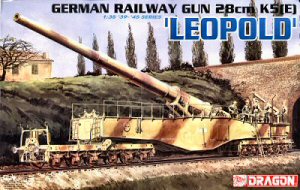
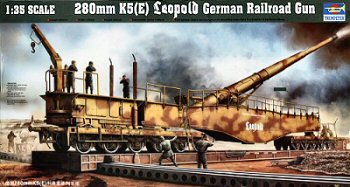
28cm K5(E) 'Leopold' German Railroad Gun
1:35 Kit Comparison
Dragon Kit No.6200 / Trumpeter Kit No.00207
Review by Terry Ashley



Having examined both the Dragon and Trumpeter kits one thing I can state quite clearly before making a direct comparison is that either kit will build into and impressive model of a K5(E) but there are other factors which could influence which is the kit for you.
In this comparison I will endeavour to highlight the major differences, the
pluses and minuses of each kit to hopefully help you make that choice, but
depending on your finances you may just buy them both and why the hell not,
what an Anzio diorama that would be with the two K5s together. (Did I hear
someone say house extensions?)
I will also include detail images of some parts to highlight the differences
in detail; these will be the parts that best illustrate these differences and
can then be translated through to the rest of the kit. During the review I
will refer to the Dragon kit as DR and the Trumpeter kit as TR to save on typing
(my two fingers do get sore) and in most cases the kits will be mentioned in
alphabetical order, eg DR, TR.
Recommended retail prices:
The DR kit price is listed as Yen ¥11800, USD $99.95 and EURO 89.95
The TR kit price is listed as Yen ¥10800, USD $139.95 and EURO 79.95
These are the recommended list prices and may vary depending on dealer discounts.
Note: The USD price for the TR kit may be revised when the kit is finally released
to reflect to other currency pricing.
Packaging:
With such large kits, the packaging can be important to protect the many parts.
The DR kit has the main chassis/hull section in a separate cardboard box inside
the main box and the embankment sections in another box at one end with a cardboard “shelf” at
the other end to support the larger sprues over the smaller sprues in the main
area of the box, there are ten plastic bags containing the sprues.
The TR kit has three smaller boxes inside the main box, one containing all
the track bed sections, one with the extra bits such as the decal sheet, etched
and metal parts. The third has the four full length hull side panels each separated
with another piece of cardboard inside the box. Twelve plastic bags of sprues
take up the rest of the box and some of these have additional cardboard and
padding taped to the sprues to protect vulnerable parts such as the thin full
length safety rails along the top of the hull.
Dragon kit contents:
This comes in a large box measuring 690mm (27.25in) x 435mm (17.1in) x 120mm
(4.75in) and contains 676 parts in light grey plastic plus an additional
71 for the 6 figures included (Total 747 parts) plus a small etched fret
with 7 parts used, a length of fine chain, a short length of twine, a decal
sheet and single double sided instruction sheet.
Trumpeter kit contents:
This comes in a large box measuring 635mm (25in), 335mm (13.5in) and 170mm
(6.75in) deep and this is filled with 1140 parts in light grey plastic, an
etched fret with 27 parts, two lengths of copper wire, a length of fine chain,
two metal shafts plus a short section of plastic tube, a sheet of mesh, roll
of thin twine and poly caps to hold the truck wheels in place plus the decal
sheet and a large 44 page instruction sheet.
To the kits:
Both kits have a high standard of moulding with flash free crisp details and
the pin ejector marks are kept to a minimum, there is some of course
when it is unavoidable due to parts with detail on both sides and the orientation
of others on the sprues. I didn’t see any sink marks on either kit
and you only have the usual cleanup of the sprue attachments and minor mould
seam lines on the parts to deal with. Both kits have some small parts that
will need care when removing from the sprues and assembling and the slightly
softer plastic on the TR kit helps a little here. (By softer I mean just
that, the plastic in the TR kit is a little easier to cut and trim, nothing
more. It is certainly not to say the plastic is either kit is inferior to the
other, in fact the details are slightly crisper in many places on the TR kit.)
Rail trucks:
One of the biggest differences between the two kits is the number of parts
that make up the two rail trucks. For the DR kit there is a total of 192
parts for the two trucks while the TR kit uses 752 parts for the two trucks,
this obviously translates into far more detail in the TR trucks.
To break this down even further the basic suspension parts of the leaf springs,
mounting brackets, axles and wheels total 104 in the DR kit and 314 in the
TR kit (Sprue G of which there are 4 contain all the suspension parts for the
TR kit).
As well as having considerably more parts the TR parts also have some finer
details and definition than those of the DR kit. The twelve wheels on each
truck are featureless on the DR kit yet the TR wheels have contours on both
faces of the wheels, the caps on the wheel hub assemblies are again plain on
the DR kit but the TR hubs feature fine embossed lettering (remembering this
is on a part 8mm [5/16in] in diameter), this typifies the detail on the TR parts.
The undersides of the trucks are also far more detailed on the TR kit as are
the details on end plates of both trucks with some of the detail being very
simplified on the DR parts compared to the TR parts, there is also some etched
parts to be added to the TR trucks which are represented with plastic parts
on the DR trucks.
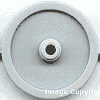
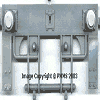
All of this obviously means there is much more assembly required in the TR trucks and some may prefer the simplified assembly of the DR kit but if you
don’t mind the extra work required for the higher level of detail then
the TR trucks are the choice.
The instructions also reflect the number of parts with the DR instruction having
just 6 steps for the two truck assembly while the TR instructions devote 11
full pages to the truck assemblies.
Mail chassis/Hull:
This is also handled differently in the two kits with the DR kit having a single
large moulding for the hull with the two sides and bottom and just the inner
side panels, top and end panels separate while the TR kit has all the side,
bottom and top panels as separate parts. Again this means more construction
time for the TR bits but the design of the two end panels and the internal
bulkheads makes the job of aligning the panels a little easier. Both kits
are impressive in that there is no warping at all in these large parts.
Externally both have additional details such as the fixed crew ladders on
the front plate and fold up crew ladders on both rear sides although the TR kit gives the option of extended or retracted ladders. The large left side
control panel is open on both kits with the door separate and crew stand to
add when shown open, the tread plate stand is provided in etched metal on the
DR kit but with flexible mesh on the TR kit. On the top hull is the forward
barrel lock (in multiple parts in both kits) and the large multi part trunnion
assembly and both kits has the bottom plate as a separate part to include the
many large bolt heads with TR providing a couple of etched parts to add to
the assemblies.
One big difference is the rear of the upper hull which has no surface detail
other than the small rail tracks on the DR kit while the TR kit has the full
wood panel walkways the same as on the engine compartment top and forward section
of the front rail truck.
Quite a few of the details are separate on the TR kit but included in the major
mouldings on the DR kit continuing the extra detail definition seen on most
TR parts. This is best highlighted by the shell loading tray for the upper
deck which is multi-part and designed to pivot on both kits but the tray itself
has more detail on the TR kit parts, both have minor pin ejector marks to be
removed but should be easy to handle.
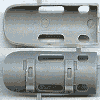
Internally both kits have the full elevation mechanism designed so you can
elevate the gun, the mouldings here are quite large and very similar in design
on both kits as you would expect as both kits are portraying the same full
size parts but again the TR parts have slightly better detail definition. The
TR kit provides two 8 x 40mm metal shafts to secure the two main pivot points
for added strength while the attachments are plastic in the DR kit, this should
be quite okay unless you intend to play with the gun moving it up and down
a lot.
Internal bulkheads are included at the front and rear of the hull compartment
on both kits but the TR kit has additional bulkheads and details to that in
the DR kit, not sure if all this can be seen after assembly but it does add
to the strength of the TR hull assembly.
The main 28cm gun:
Again the design of the main gun is similar on both kits with the TR kit having
a number of multi-part assemblies where they are in one piece on the DR kit,
the main barrel support being one example of this, but on the reverse the
front section of the main mounting is in four parts on the DR kit but included
in the large mountings halves on the TR kit. The differences in part engineering
result in the same barrel assembly at the end of the day although the TR parts again have finer detail definition.
This is best illustrated on the huge breech end section detail and the addition
of external wiring (provided in the kit) on the TR barrel assembly. The TR instructions show clearly where this wiring goes and this does add a lot to
the overall detail effect of the assembly, this wiring is not included in the
DR kit.
Both kits have 28cm shells included, four in the DR kit and two in the TR kit.
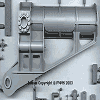
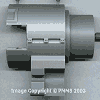
Rear engine compartment/loading platform:
This compartment in both kits is made up of separate side, end, top and bottom
panels except that the DR kit doesn’t have a bottom panel not that
you probably notice once attached to the rail truck?
The details on the side panels are nice on both with the left panel on the
DR kit having three compartments with separate doors so you can show
these open if you wish with all panels moulded closed on the TR kit.
Rail and embankments:
Both kits provide the rail segments to sit your K5 on and are basically the
same design with sections of embankment, separate sleepers with clips that
you slide the lengths of rail through to hold in place.
The big question here is; are the rail track widths the same on both kits which
would allow the interchange of the tracks? The answer is that they are not
the same with the width of the DR track being 41mm while
the
TR track is 44.5mm wide.
Assembly of the track sections is fairly straight forward but you should follow
the instructions when assembling these as there are differences in the parts
especially with the DR sleepers.
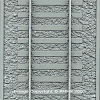
Decals:
Both kits offer basically the same decals with the large name “Leopold” and
a selection of stencilling. Both the decal sheets have some minor spelling
errors on the smaller stencilling
but as these
words are
only about 1mm high it may not be that noticeable?
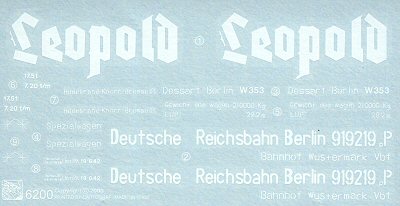

Instructions:
These best highlight the differences in the number of parts and complexity
of the kits contents with the DR kit having a single double sided instruction
sheet that folds out to 840mm (33in) x 500mm (19.75in) with 19 construction
step plus the painting guide and sprue layout drawings.
The TR kit on the other hand has a small booklet in the Squadron
Signal in-action
style with 44 pages of construction sequences including eight pages with the
different track layouts and their assembly. The DR instructions are adequate
for the parts but do omit a few things such as the fine chain for the top
railings but are easy to follow. The TR instructions while being much
more complex were also easy to follow with additional diagrams to add the
wiring
in the gun and rail trucks. Both give the painting guide for the “Leopold” in
Dark Yellow/Red Brown scheme and in overall Panzer Grey.
DR Instruction
Sheets.
TR Instruction
Sheets.
(Will open in new window, only close that window when you have finished
navigating through the pages.)
Figures:
The DR kit provides six nice crew figures for the gun with the figure
sprue marked as “1/35 Karl-Geraet crew” , this set has been
scheduled for release separately in October as set No.6201.
TR have also released a set of eight K5 Crew Figures to offer some additional choice on crewing your K5
Both kits when assembled measure out to approximately 960mm (38in) in length and 130mm (5in) wide (width of the embankment sections) give or take a few mm (in), this is based on the TR kit on the straight section of track with a much larger area needed for the cross section track layout.
Conclusion:
It is clear from the close examination of the parts that the DR K5 is simplified
in many areas much like their earlier Karl Morser but due to its large size
will still build into an impressive looking model. That is not to say there
is anything wrong in that as some may like the simplification and ease of
assembly?
But thankfully we have a choice with the K5 and if you prefer a far higher
level of detailing and don’t mine the extra work involved with the additional
parts and complexity of the TR kit then this would be the go.
Given that the price difference is minimal the TR kit also offers good value
with the almost 400 extra parts than in the DR kit but then you do get the
bonus figures with the DR kit.
Personally I prefer the extra level of detail definition in the TR kit but the final decision is up to the individual modeller and hopefully this comparison will aid that decision and as I have mentioned earlier both will build into very impressive looking models.
The other thing that is clear is that this kit is easily the best thing
TR has done to date and promises well for the future.
Let’s hope that the other Karl kits previously announced do eventuate
so we have the same choice there, but the horse may have bolted on that
one.
See the first look reviews of the two K5 kits for images of the sprues
and other details:
Dragon 28cm
K5(E) Leopold
Railway Gun.
Trumpeter 280mm
K5(E) Leopold
Railroad Gun.
References:
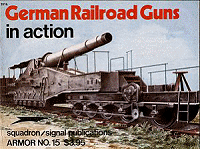
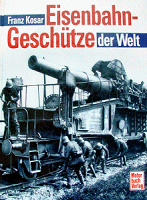
Page created 3 August 2003
Page updated 4 August 2003